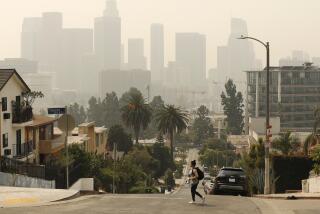EPA Blows Smoke on Risk of Breathing It : Government, juggling statistics, reaches a conclusion to match its flawed hypothesis.
- Share via
Does the truth matter? Evidently not, when it comes to attacking the tobacco industry. Respectable newspapers like this one carried the “Doonesbury” cartoon strip that branded tobacco executives, by name, as indicted for perjury. True, there was an editor’s disclaimer in The Times advising that it was merely satire, but previous “Doonesbury” strips smearing individuals, including one that linked Frank Sinatra with organized crime, were not printed. Apparently tobacco executives are subject to a lower standard of fair play.
The New York Times brazenly asserted just that in an editorial last week: “Americans generally think it unsporting to kick an opponent who is down. But the sellers of cigarettes, given their history of arrogance and mendacity, provide a target too tempting, and deserving, to resist.”
Thus, without examining the evidence, the newspaper accused industry executives of chicanery for daring to challenge the EPA’s labeling environmental tobacco smoke a Class A carcinogen.
Well, this time the tobacco industry seems to be right. This time it is the EPA that appears to have juggled statistics.
The EPA conducted no new studies in rendering its judgment on secondhand smoke. Instead, the agency re-evaluated the results of 30 previous studies done throughout the world on couples in which only one spouse smoked.
Amazingly, those studies made as strong a case for a protective effect from breathing secondhand smoke as they did for a deleterious outcome. As the Congressional Research Service pointed out, “six (studies) found a statistically significant (but small) effect, 24 found no statistically significant effect and six of the 24 found a passive smoking effect opposite to the expected relationship.”
What to do? After summarizing those worldwide results, the EPA chose to ignore all but the 11 studies that had been conducted within the United States. Perhaps there are valid reasons for such narrowing of the inquiry on the grounds that home-grown data are more relevant and more easily monitored.
But why then did the EPA also ignore the largest and most recent U.S. study, conducted in 1992 for the National Cancer Institute? Perhaps it was disappointment with the study’s conclusion: “We found no statistically significant increase in risk associated with exposure to environmental tobacco smoke at work or during social activities.”
Even the 11 previous U.S. studies that the EPA chose to use as the basis for its report did not provide a significant link between secondhand smoke and lung cancer. The EPA then readjusted the data in the original studies to see if the results might come out differently. But despite such efforts, 10 of the 11 studies still showed no statistically significant connection.
Faced with this challenge to its a priori hypothesis, the EPA simply changed its research rules: It combined the 11 studies into one and changed the acceptable margin of error from 5% to 10%. Eureka! At last a slight correlation could be shown. How slight? They predicted that in a nation of more than 250 million people, 3,000 would die of lung cancer as a result of secondhand smoke. About the same chance as dying in a bicycle accident.
This is a very thin reed on which to base sweeping changes in public policy. As the Congressional Research Service noted after evaluating the EPA’s methodology: “It is unusual to return to a study after the fact, lower the required significance level and declare its results to be supportive rather than unsupportive of the effect one’s theory suggests should be present.”
That polite but devastating analysis suggests that it is anti-smoking hysteria and not science that is driving policy here. We would expect that from advocates on various sides of an issue, but not from a government agency whose data we need to trust if we are to follow its recommendations.
Lifestyle changes do not come easily. A very strong case can be made for giving up smoking, and failing that, for being considerate of others. The good news is that there is general agreement that secondhand smoke dilutes quickly in open air or well-ventilated places, making this a fixable problem if there is goodwill.
But we are not going to alter the behavior of 50 million smokers by making them pariahs or by holding tobacco executives responsible for a habit that adults choose despite all the warnings. One can make the case for smoke-free public spaces on the basis of civility alone, without piling on the false guilt about killing people with secondhand smoke.
More to Read
Get the L.A. Times Politics newsletter
Deeply reported insights into legislation, politics and policy from Sacramento, Washington and beyond. In your inbox twice per week.
You may occasionally receive promotional content from the Los Angeles Times.










